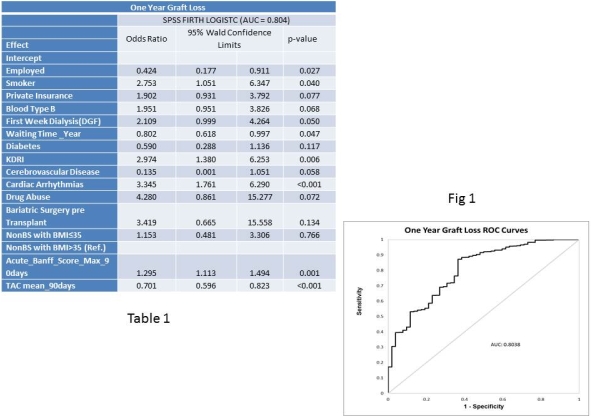Determinants of 1 Year Graft Loss After Pre Kidney Transplant Bariatric Surgery.
Medical Unversity of South Carolina, Charleston, SC.
Meeting: 2016 American Transplant Congress
Abstract number: D310
Keywords: Graft failure, Kidney transplantation, Obesity, Surgical complications
Session Information
Session Name: Poster Session D: Late Breaking
Session Type: Poster Session
Date: Tuesday, June 14, 2016
Session Time: 6:00pm-7:00pm
 Presentation Time: 6:00pm-7:00pm
Presentation Time: 6:00pm-7:00pm
Location: Halls C&D
Background: Bariatric surgery (BS) is increasingly used to manage weight pre-transplantation (Pre-Tx). However, grafts may be compromised by variable drug absorption, rejection and oxalate nephropathy. We studied relationships between BS, tacrolimus (Tac) exposure, rejection (AR) and 1 yr graft loss (GL).
Methods: In a large-scale quality improvement endeavor, we developed a predictive risk model to assess associations between Pre-Tx BS and 1-yr GL, then added Tac exposure measures (Tac Mean C0, FKM; Time to Tac C0 = 8-12 ng/mL and SD of Tac C0 0-90 days), and acute Banff scores to the model. We included adult solitary kidney transplant recipients transplanted 2007 – 2015. We used Natural language processing to extract Banff lesion scores from the EMR. We excluded 1) patients without recorded BMI at transplant, and 2) patients who did not have a GL recorded or other data during the first year post-transplant. The primary covariates were: 1) patients with BS Pre-Tx, 2) patients with BMI ≤ 35 without BS, and 3) patients with BMI >35 without BS (reference). IBM SPSS Modeler and Essentials for R were used for analysis. The Backward Selection Process was used at the 20% level for variable selection, and statistical significance was determined at the 5% level.
Results: Of 1167 patients, 5% experienced 1 yr GL. There were 31 patients who received BS prior to transplant, 974 patients with BMI ≤ 35 without BS, and 162 patients with BMI >35 without BS (reference). Patients with BS prior to transplant trended 3.41 times more likely to have 1-year GL than those with BMI > 35 without BS (reference). Acute rejection and lower FKM were risk factors for GL  .The predictive model AUC was 0.80 (95% CI: 0.74-0.86)
.The predictive model AUC was 0.80 (95% CI: 0.74-0.86)  suggesting formidable model accuracy.
suggesting formidable model accuracy.
Conclusion: Patients with bariatric surgery have increased graft loss risk as compared to patients with BMI > 35 without BS. In our model, achieving FKM levels and lower AR rates didn't lower the risk of 1 yr GL in BS. Results suggest that optimizing renal graft outcomes in BS patients will require a multipronged approach to optimize tacrolimus exposure, minimize rejection and minimize oxalate exposure.
CITATION INFORMATION: Mour G, Zhang J, Su Z, Taber D, Mauldin P, Srinivas T. Determinants of 1 Year Graft Loss After Pre Kidney Transplant Bariatric Surgery. Am J Transplant. 2016;16 (suppl 3).
To cite this abstract in AMA style:
Mour G, Zhang J, Su Z, Taber D, Mauldin P, Srinivas T. Determinants of 1 Year Graft Loss After Pre Kidney Transplant Bariatric Surgery. [abstract]. Am J Transplant. 2016; 16 (suppl 3). https://atcmeetingabstracts.com/abstract/determinants-of-1-year-graft-loss-after-pre-kidney-transplant-bariatric-surgery/. Accessed December 19, 2025.« Back to 2016 American Transplant Congress
